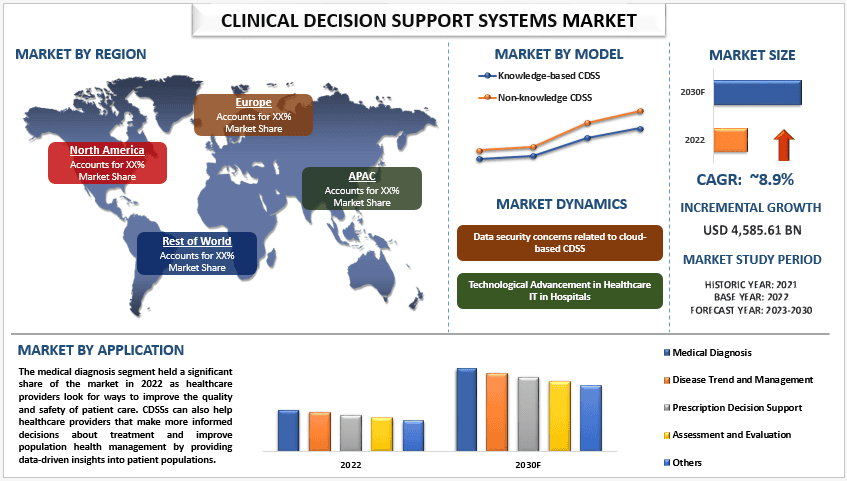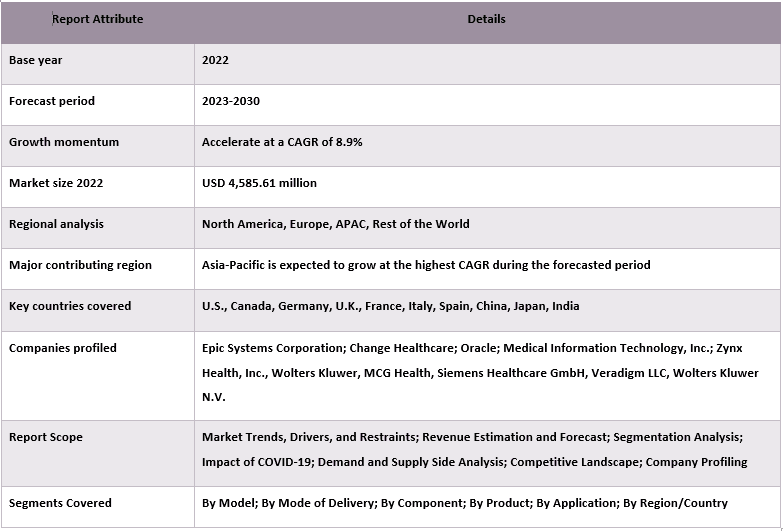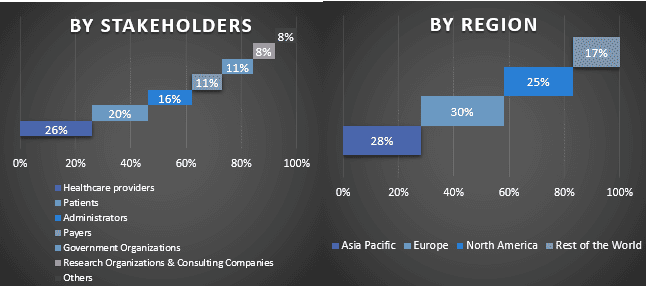- Home
- About Us
- Industry
- Services
- Reading
- Contact Us
Clinical Decision Support Systems Market: Current Analysis and Forecast (2023-2030)
Emphasis on Model (Knowledge-Based CDSS, Non-Knowledge CDSS); Mode of Delivery (On-Premise Systems, Web-Based Systems, Cloud-Based Systems); Component (Hardware, Software, Services); Product (Integrated CDSS, Standalone CDSS); and Application (Medical Diagnosis, Disease Trend and Management, Prescription Decision Support, Assessment and Evaluation, Others); and Region/Country

The Clinical Decision Support Systems market was valued at USD 4,585.61 million in 2022 & expected to grow at a strong CAGR of 8.9% during the forecast period (2023-2030). CDSSs are computer-based systems that provide healthcare providers with information and tools to support clinical decision-making. Adding to this, CDSSs can be integrated into electronic health records (EHRs) and provide real-time, patient-specific information to healthcare providers at the point of care. Around 88 percent of hospitals participating in electronic health data exchange as of 2021, according to an ONC data brief based on the AHA Information Technology (IT) Supplement to the AHA Annual Survey. The growth of AI, machine learning, and data analytics capabilities enhances the effectiveness of CDSS which drives the growth of the market. These technologies can analyze vast amounts of data and provide more accurate and relevant recommendations. Moreover, increasing emphasis on patient outcomes and medical errors to reduce healthcare costs.
Some of the major players operating in the market include Epic Systems Corporation; Change Healthcare; Oracle; Medical Information Technology, Inc.; Zynx Health, Inc., Wolters Kluwer, MCG Health, Siemens Healthcare GmbH, Veradigm LLC, Wolters Kluwer N.V. Several M&As along with partnerships have been undertaken by these players to facilitate customers with hi-tech and innovative products/technologies.
Insights Presented in the Report
“Amongst model, non-knowledge is expected to grow at a substantial CAGR during the forecasted period (2023-2030).”
Based on the market is segmented into knowledge-based CDSS and non-knowledge CDSS. Amongst these, the non-knowledge is expected to grow at a substantial CAGR during the forecasted period (2023-2030). The growth of non-knowledge CDSS is driven by the increasing availability of electronic health records and the proliferation of digital healthcare data. They contribute to improved efficiency and reduced errors in diagnosis and treatment by flagging inconsistencies and potential issues that may be overlooked by human clinicians alone.
“Amongst products, the integrated CDSS is expected to grow at a substantial CAGR during the forecasted period (2023-2030).”
Based on the product, the market is segmented into integrated CDSS and standalone CDSS. Amongst these, the integrated CDSS is expected to grow at a substantial CAGR during the forecasted period (2023-2030). Integrated CDSS is its ability to streamline clinical workflows. By accessing patient data directly from the EHR, healthcare providers can receive tailored recommendations and alerts based on the patient’s medical history, current condition, and potential drug interactions. This real-time guidance not only reduces the risk of medical errors but also accelerates the decision-making process, enabling quicker interventions when necessary.
Amongst applications, amongst these, the medical diagnosis segment dominated the market in 2022.”
Based on application, the market is segmented into medical diagnosis, disease trends and management, prescription decision support, assessment and evaluation, and others. Amongst these, the medical diagnosis segment dominated the market in 2022. CDSS growth through medical diagnosis is the increasing complexity of healthcare data. With the proliferation of electronic health records (EHRs) and medical imaging, there’s a wealth of information that needs to be efficiently processed and analyzed. CDSS leverages software to sift through this data, identifying relevant patterns and correlations that may not be immediately apparent to human clinicians. This assists in early disease detection, personalized treatment planning, and more precise diagnoses.
“Asia-Pacific has extensive growth”
Asia-Pacific is expected to grow with a significant CAGR during the forecast period. This growth is driven by factors such as increasing adoption of advanced healthcare technologies, rising healthcare awareness, a growing geriatric population, and an increasing prevalence of chronic diseases. As per the Asian Developmental Bank, by 2050, one in four people in Asia and the Pacific will be over 60 years old. The population of older persons (aged over 60) in the region will triple between 2010 and 2050, reaching close to 1.3 billion people. The demand for accurate and timely clinical decision-making tools has paved the way for CDSS adoption, enabling healthcare professionals to make informed decisions and enhance patient outcomes.
Clinical Decision Support Systems Market Report Coverage

Reasons to buy this report:
- The study includes market sizing and forecasting analysis validated by authenticated key industry experts.
- The report presents a quick review of overall industry performance at one glance.
- The report covers an in-depth analysis of prominent industry peers with a primary focus on key business financials, product portfolios, expansion strategies, and recent developments.
- Detailed examination of drivers, restraints, key trends, and opportunities prevailing in the industry.
- The study comprehensively covers the market across different segments.
- Deep dive regional level analysis of the industry.
Customization Options:
The global clinical decision support systems market can further be customized as per the requirement or any other market segment. Besides this, UMI understands that you may have your own business needs, hence feel free to connect with us to get a report that completely suits your requirements.
Table of Content
Research Methodology for the Clinical Decision Support Systems Market Analysis (2023-2030)
Analyzing the historical market, estimating the current market, and forecasting the future market of the global clinical decision support systems market were the three major steps undertaken to create and analyze the adoption of clinical decision support systems in major regions globally. Exhaustive secondary research was conducted to collect the historical market numbers and estimate the current market size. Secondly, to validate these insights, numerous findings and assumptions were taken into consideration. Moreover, exhaustive primary interviews were also conducted, with industry experts across the value chain of the global clinical decision support systems market. Post assumption and validation of market numbers through primary interviews, we employed a top-down/bottom-up approach to forecasting the complete market size. Thereafter, market breakdown and data triangulation methods were adopted to estimate and analyze the market size of segments and sub-segments of the industry pertains to. Detailed methodology is explained below:
Analysis of Historical Market Size
Step 1: In-Depth Study of Secondary Sources:
Detail secondary study was conducted to obtain the historical market size of the clinical decision support systems market through company internal sources such as annual reports & financial statements, performance presentations, press releases, etc., and external sources including journals, news & articles, government publications, competitor publications, sector reports, third-party database, and other credible publications.
Step 2: Market Segmentation:
After obtaining the historical market size of the clinical decision support systems market, we conducted a detailed secondary analysis to gather historical market insights and share for different segments & and sub-segments for major regions. Major segments are included in the report as a model, mode of delivery, component, product, and application. Further country-level analyses were conducted to evaluate the overall adoption of testing models in that region.
Step 3: Factor Analysis:
After acquiring the historical market size of different segments and sub-segments, we conducted a detailed factor analysis to estimate the current market size of the clinical decision support systems market. Further, we conducted factor analysis using dependent and independent variables such as model, mode of delivery, component, product, and application of the clinical decision support systems market. A thorough analysis was conducted for demand and supply-side scenarios considering top partnerships, mergers and acquisitions, business expansion, and product launches in the clinical decision support systems market sector across the globe.
Current Market Size Estimate & Forecast
Current Market Sizing: Based on actionable insights from the above 3 steps, we arrived at the current market size, key players in the global clinical decision support systems market, and market shares of the segments. All the required percentage shares split, and market breakdowns were determined using the above-mentioned secondary approach and were verified through primary interviews.
Estimation & Forecasting: For market estimation and forecast, weights were assigned to different factors including drivers & trends, restraints, and opportunities available for the stakeholders. After analyzing these factors, relevant forecasting techniques i.e., the top-down/bottom-up approach were applied to arrive at the market forecast for 2028 for different segments and sub-segments across the major markets globally. The research methodology adopted to estimate the market size encompasses:
- The industry’s market size, in terms of revenue (USD) and the adoption rate of the clinical decision support systems market across the major markets domestically
- All percentage shares, splits, and breakdowns of market segments and sub-segments
- Key players in the global clinical decision support systems market in terms of products offered. Also, the growth strategies adopted by these players to compete in the fast-growing market
Market Size and Share Validation
Primary Research: In-depth interviews were conducted with the Key Opinion Leaders (KOLs) including Top Level Executives (CXO/VPs, Sales Head, Marketing Head, Operational Head, Regional Head, Country Head, etc.) across major regions. Primary research findings were then summarized, and statistical analysis was performed to prove the stated hypothesis. Inputs from primary research were consolidated with secondary findings, hence turning information into actionable insights.
Split of Primary Participants in Different Regions

Market Engineering
The data triangulation technique was employed to complete the overall market estimation and to arrive at precise statistical numbers for each segment and sub-segment of the global clinical decision support systems market. data was split into several segments & sub-segments post studying various parameters and trends in the areas of the model, mode of delivery, component, product, and application in the global clinical decision support systems market.
The main objective of the Global Clinical decision support systems Market Study
The current & future market trends of the global clinical decision support systems market were pinpointed in the study. Investors can gain strategic insights to base their discretion for investments on the qualitative and quantitative analysis performed in the study. Current and future market trends determined the overall attractiveness of the market at a regional level, providing a platform for the industrial participant to exploit the untapped market to benefit from a first-mover advantage. Other quantitative goals of the studies include:
- Analyze the current and forecast market size of the clinical decision support systems market in terms of value (USD). Also, analyze the current and forecast market size of different segments and sub-segments
- Segments in the study include areas of the model, mode of delivery, component, product, application
- Define and analysis of the regulatory framework for the clinical decision support systems industry
- Analyze the value chain involved with the presence of various intermediaries, along with analyzing customer and competitor behaviors of the industry
- Analyze the current and forecast market size of the clinical decision support systems market for the major region
- Major countries of regions studied in the report include Asia Pacific, Europe, North America, and the Rest of the World
- Company profiles of the clinical decision support systems market and the growth strategies adopted by the market players to sustain in the fast-growing market
- Deep dive regional level analysis of the industry
Related Reports
Customers who bought this item also bought










